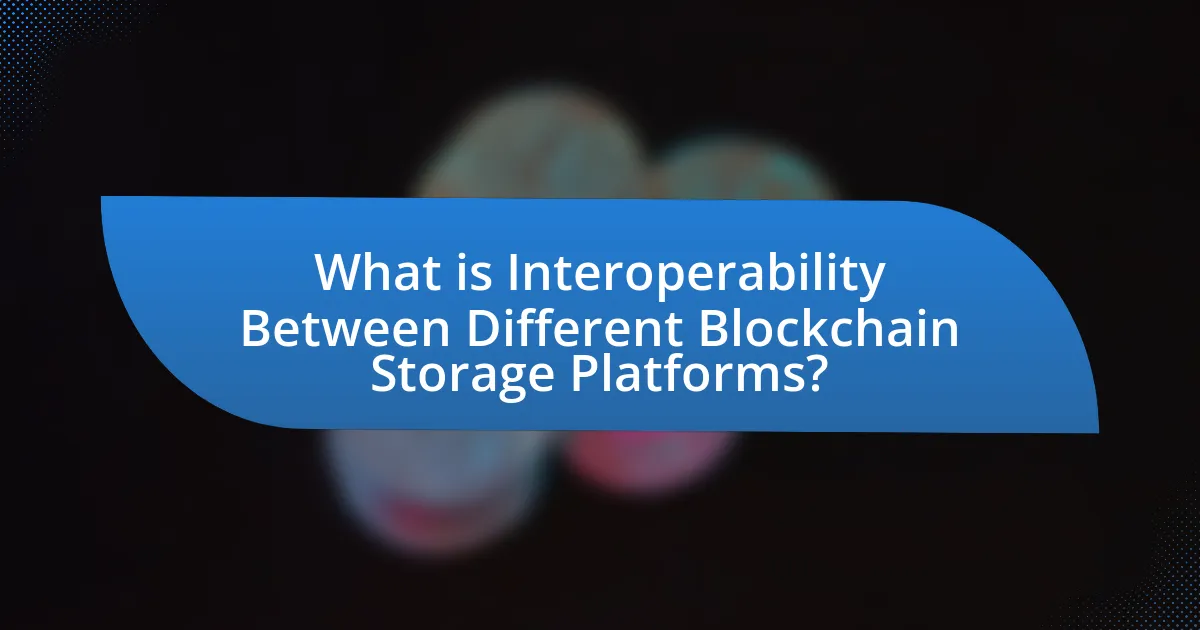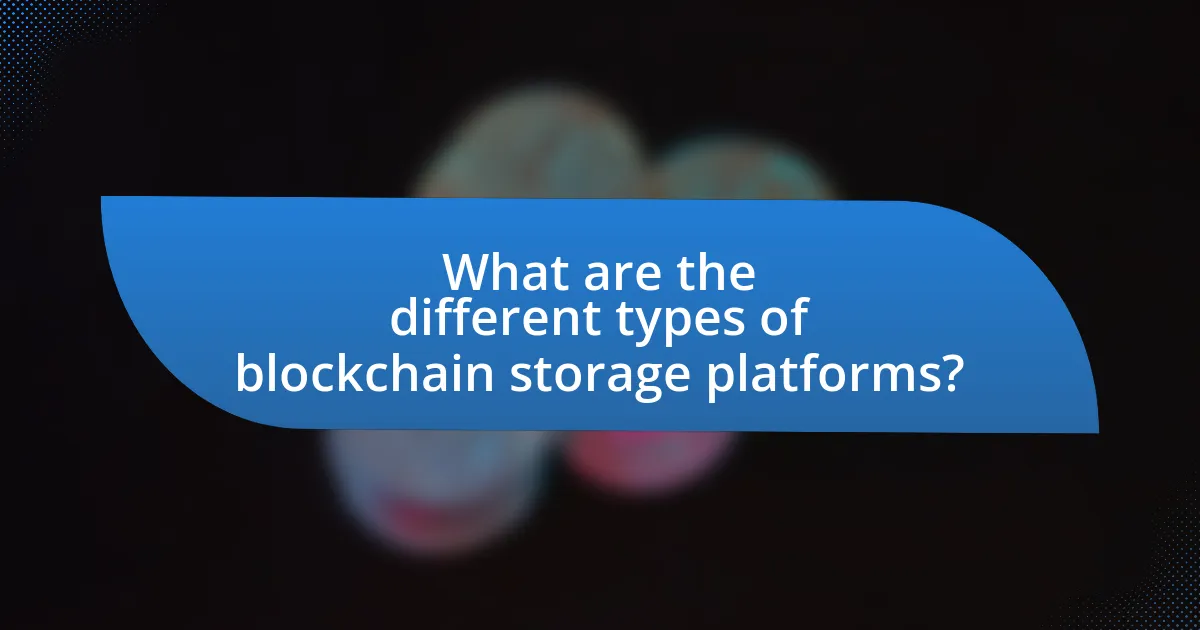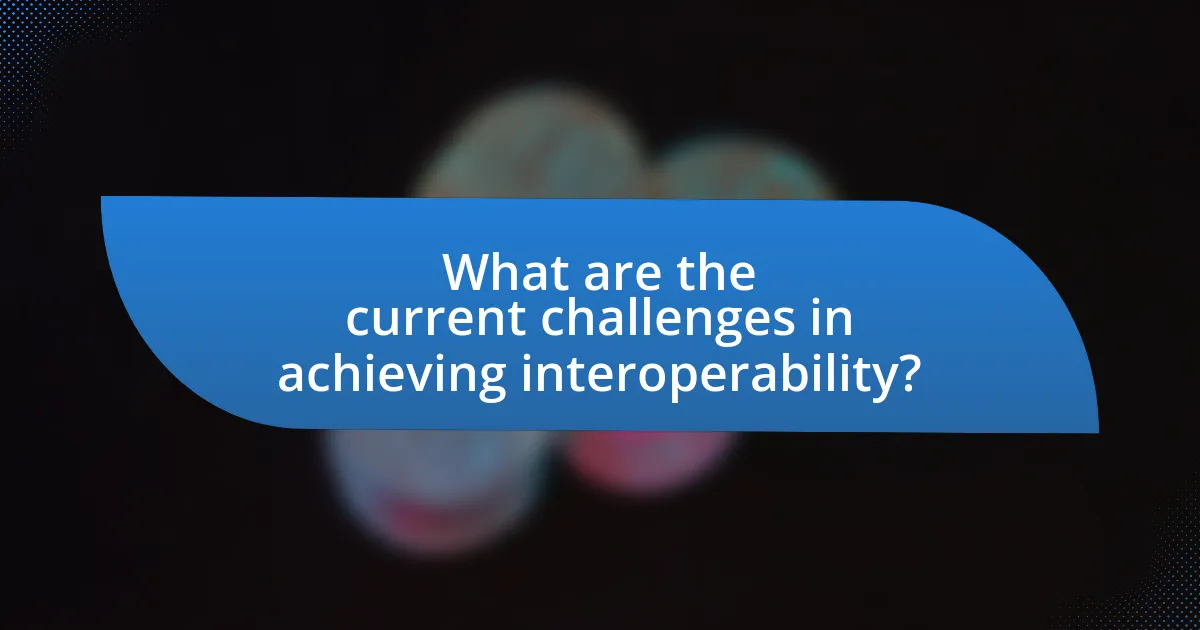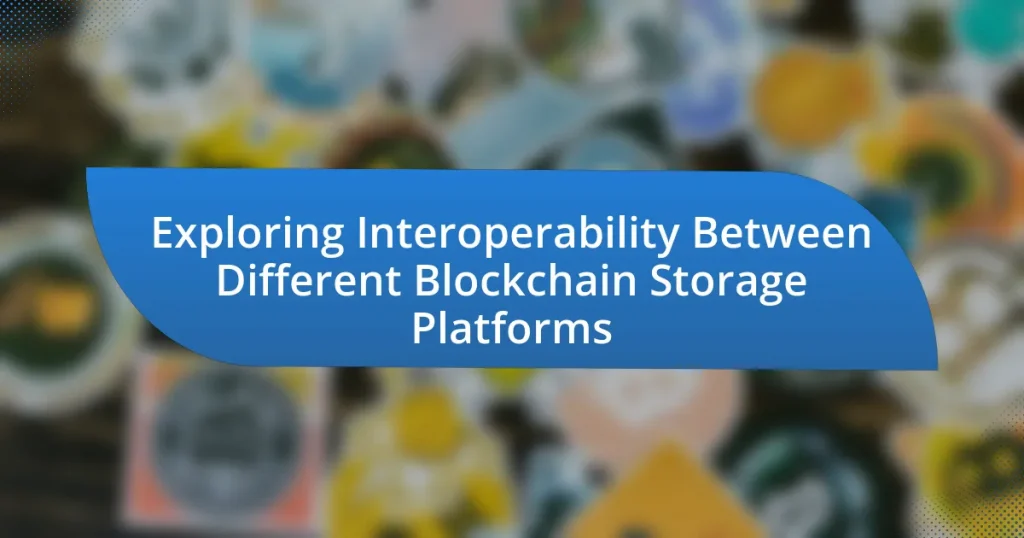Interoperability between different blockchain storage platforms is the ability of distinct blockchain systems to communicate, share data, and execute transactions seamlessly. This article explores the mechanisms that enable interoperability, including standardized protocols, cross-chain communication, and shared data formats, highlighting their importance for enhancing user experience and efficiency in decentralized applications. It also addresses the challenges posed by technical incompatibilities, varying consensus mechanisms, and regulatory issues that hinder interoperability. Additionally, the article discusses the role of decentralized storage solutions in promoting data accessibility and security, as well as future trends and best practices for organizations to improve interoperability in blockchain ecosystems.

What is Interoperability Between Different Blockchain Storage Platforms?
Interoperability between different blockchain storage platforms refers to the ability of distinct blockchain systems to communicate, share data, and execute transactions seamlessly. This capability is essential for enhancing the functionality and usability of blockchain technology, as it allows for the integration of various decentralized applications and services across multiple platforms. For instance, projects like Polkadot and Cosmos are designed specifically to facilitate interoperability by enabling different blockchains to transfer data and value without intermediaries. This interconnectedness can lead to increased efficiency, reduced costs, and a broader range of applications in the blockchain ecosystem.
How does interoperability function in blockchain storage?
Interoperability in blockchain storage enables different blockchain networks to communicate and share data seamlessly. This function is achieved through protocols and standards that facilitate cross-chain interactions, allowing assets and information to move between distinct blockchain platforms. For instance, technologies like atomic swaps and cross-chain bridges exemplify how interoperability can be implemented, enabling transactions without the need for a centralized intermediary. The importance of interoperability is underscored by the growing demand for decentralized applications that require access to multiple blockchain ecosystems, enhancing usability and expanding the potential for decentralized finance and other applications.
What are the key components that enable interoperability?
The key components that enable interoperability between different blockchain storage platforms include standardized protocols, cross-chain communication mechanisms, and shared data formats. Standardized protocols, such as the Interledger Protocol, facilitate transactions across diverse blockchain networks by providing a common framework for communication. Cross-chain communication mechanisms, like atomic swaps and bridges, allow for the transfer of assets and information between separate blockchains, ensuring seamless interaction. Shared data formats, such as JSON or XML, enable different systems to understand and process data consistently, further enhancing interoperability. These components collectively ensure that various blockchain platforms can work together effectively, promoting a more integrated ecosystem.
How do different blockchain protocols interact with each other?
Different blockchain protocols interact with each other primarily through interoperability solutions such as cross-chain bridges, atomic swaps, and interoperability protocols like Polkadot and Cosmos. Cross-chain bridges enable the transfer of assets and data between distinct blockchains, allowing users to leverage the unique features of each protocol. Atomic swaps facilitate peer-to-peer exchanges of cryptocurrencies across different blockchains without the need for intermediaries, enhancing liquidity and user choice. Furthermore, interoperability protocols like Polkadot utilize a relay chain to connect multiple blockchains, enabling them to share information and functionality seamlessly. These mechanisms are essential for creating a cohesive ecosystem where diverse blockchain networks can collaborate and enhance their overall utility.
Why is interoperability important for blockchain storage platforms?
Interoperability is crucial for blockchain storage platforms because it enables seamless data exchange and collaboration across different blockchain networks. This capability enhances user experience by allowing diverse systems to communicate, share, and utilize data without friction. For instance, according to a report by the World Economic Forum, interoperability can significantly increase the efficiency of blockchain applications, leading to reduced costs and improved scalability. By facilitating cross-chain interactions, interoperability also fosters innovation, as developers can leverage the strengths of multiple platforms to create more robust solutions.
What challenges does lack of interoperability create?
Lack of interoperability creates significant challenges in blockchain storage platforms, primarily hindering data exchange and collaboration across different systems. This limitation results in fragmented ecosystems where users cannot seamlessly transfer assets or information, leading to inefficiencies and increased operational costs. For instance, a study by the World Economic Forum highlights that without interoperability, blockchain networks cannot leverage shared data, which stifles innovation and slows down the adoption of decentralized applications. Additionally, the inability to communicate effectively between platforms can lead to security vulnerabilities, as isolated systems may not benefit from collective security measures.
How does interoperability enhance user experience and efficiency?
Interoperability enhances user experience and efficiency by enabling seamless communication and data exchange between different blockchain platforms. This capability allows users to access and utilize services across multiple systems without the need for complex integrations or manual data transfers. For instance, a study by the World Economic Forum highlights that interoperability can reduce transaction times and costs by facilitating direct interactions between various blockchain networks, thereby streamlining processes and improving overall user satisfaction.

What are the different types of blockchain storage platforms?
The different types of blockchain storage platforms include public blockchains, private blockchains, hybrid blockchains, and decentralized storage networks. Public blockchains, such as Bitcoin and Ethereum, allow anyone to participate and store data, ensuring transparency and security through consensus mechanisms. Private blockchains, like Hyperledger Fabric, restrict access to a select group of participants, providing enhanced privacy and control over data. Hybrid blockchains combine elements of both public and private systems, allowing for flexibility in data sharing and governance. Decentralized storage networks, such as IPFS and Filecoin, utilize distributed nodes to store data securely and efficiently, promoting redundancy and resilience. Each type serves distinct use cases, catering to varying needs for security, accessibility, and control in blockchain applications.
How do public and private blockchains differ in terms of storage?
Public and private blockchains differ significantly in terms of storage capacity and accessibility. Public blockchains, such as Bitcoin and Ethereum, store all transaction data on a decentralized network accessible to anyone, leading to larger storage requirements as the entire history of transactions must be maintained by all nodes. In contrast, private blockchains, like Hyperledger Fabric, allow only authorized participants to access the data, resulting in a more controlled storage environment where data can be selectively stored and managed, often leading to reduced storage needs. This difference is evident as public blockchains require nodes to maintain a complete copy of the ledger, while private blockchains can implement strategies like data pruning or off-chain storage to optimize their storage solutions.
What are the advantages and disadvantages of public blockchain storage?
Public blockchain storage offers transparency and decentralization as its primary advantages, allowing anyone to verify transactions and data without a central authority. This transparency enhances trust among users and reduces the risk of data manipulation. However, the disadvantages include scalability issues and slower transaction speeds due to the consensus mechanisms required for validation, which can hinder performance as the network grows. Additionally, public blockchains are susceptible to privacy concerns, as all data is visible to anyone on the network, potentially exposing sensitive information.
What are the advantages and disadvantages of private blockchain storage?
Private blockchain storage offers advantages such as enhanced security and control over data, as access is restricted to authorized participants, reducing the risk of unauthorized access. Additionally, private blockchains can provide faster transaction speeds and lower costs due to fewer participants and less computational power required for consensus mechanisms compared to public blockchains.
However, disadvantages include limited transparency and trust, as the centralized nature may lead to concerns about data integrity and manipulation by the controlling entity. Furthermore, private blockchains may face challenges in interoperability with public blockchains, which can hinder data sharing and collaboration across different platforms.
What role do decentralized storage solutions play in interoperability?
Decentralized storage solutions enhance interoperability by providing a unified framework for data access across multiple blockchain platforms. These solutions, such as IPFS and Filecoin, enable seamless data sharing and retrieval, allowing different blockchains to interact without centralized control. For instance, decentralized storage can facilitate cross-chain applications by ensuring that data stored on one blockchain can be accessed and utilized by another, thereby promoting collaboration and reducing data silos. This capability is crucial for the development of decentralized applications that require data from various sources, ultimately fostering a more interconnected blockchain ecosystem.
How do decentralized storage platforms enhance data accessibility?
Decentralized storage platforms enhance data accessibility by distributing data across multiple nodes, ensuring that users can access their information from various locations without relying on a single point of failure. This architecture allows for improved redundancy and availability, as data remains accessible even if some nodes go offline. For instance, platforms like IPFS (InterPlanetary File System) utilize a peer-to-peer network to store and retrieve files, which significantly reduces latency and increases the speed of access. Additionally, decentralized storage solutions often employ cryptographic methods to secure data, allowing users to maintain control over their information while still ensuring it is readily available when needed.
What are the security implications of using decentralized storage?
Decentralized storage enhances security by reducing the risk of data breaches and single points of failure. In traditional centralized systems, a single entity controls data, making it vulnerable to attacks; however, decentralized storage distributes data across multiple nodes, which mitigates this risk. For instance, a study by the University of Cambridge found that decentralized systems can significantly lower the likelihood of data loss due to their redundancy and fault tolerance. Additionally, encryption is often employed in decentralized storage, ensuring that even if data is intercepted, it remains unreadable without the proper decryption keys. This layered security approach makes decentralized storage a robust alternative to centralized solutions.

What are the current challenges in achieving interoperability?
The current challenges in achieving interoperability between different blockchain storage platforms include technical incompatibilities, varying consensus mechanisms, and differing data formats. Technical incompatibilities arise because each blockchain may use distinct protocols and architectures, making it difficult for them to communicate effectively. Varying consensus mechanisms, such as proof of work versus proof of stake, create barriers to seamless interaction, as each blockchain operates under different rules for validating transactions. Additionally, differing data formats complicate the exchange of information, as data structures may not align across platforms, leading to potential misinterpretations or loss of data integrity. These challenges hinder the development of unified systems that can leverage the strengths of multiple blockchains.
What technical barriers exist for blockchain storage interoperability?
Technical barriers for blockchain storage interoperability include differing consensus mechanisms, data formats, and protocols among various blockchain platforms. These discrepancies hinder seamless communication and data exchange, as each blockchain may utilize unique methods for validating transactions and storing data. For instance, Ethereum employs a proof-of-work consensus, while other platforms like Cardano use proof-of-stake, complicating interoperability efforts. Additionally, the lack of standardized APIs and interoperability protocols further exacerbates these challenges, making it difficult for developers to create solutions that can operate across multiple blockchains.
How do differences in consensus mechanisms affect interoperability?
Differences in consensus mechanisms significantly affect interoperability by determining how various blockchain networks validate transactions and achieve agreement. For instance, Proof of Work (PoW) and Proof of Stake (PoS) utilize distinct methods for transaction validation, which can create barriers to seamless communication between networks. PoW relies on computational power and energy consumption, while PoS depends on the amount of cryptocurrency held by validators. These fundamental differences can lead to challenges in cross-chain interactions, as protocols must bridge the gap between varying validation processes. Furthermore, the lack of standardized consensus protocols can hinder the development of interoperability solutions, as each blockchain may require tailored approaches to facilitate communication and data exchange.
What role does data format standardization play in interoperability?
Data format standardization is crucial for interoperability as it ensures that different systems can effectively communicate and exchange information without misinterpretation. By adhering to common data formats, blockchain platforms can facilitate seamless integration and interaction, allowing for the sharing of data across diverse systems. For instance, the use of standardized formats like JSON or XML enables various blockchain applications to interpret and process data uniformly, reducing errors and enhancing compatibility. This standardization is supported by industry initiatives such as the W3C’s Linked Data principles, which promote interoperability across web technologies, demonstrating its importance in creating a cohesive ecosystem among different blockchain storage platforms.
What regulatory and compliance issues impact interoperability?
Regulatory and compliance issues impacting interoperability primarily include data privacy laws, security regulations, and industry-specific compliance standards. Data privacy laws, such as the General Data Protection Regulation (GDPR) in Europe, impose strict requirements on how personal data is handled, which can hinder the seamless exchange of information across different blockchain platforms. Security regulations, including those set by the Financial Industry Regulatory Authority (FINRA) and the Securities and Exchange Commission (SEC), mandate specific security measures that must be adhered to, potentially complicating interoperability efforts. Additionally, industry-specific compliance standards, such as those in healthcare (HIPAA) or finance (PCI DSS), require adherence to particular protocols that can limit the ability of different blockchain systems to communicate effectively. These regulatory frameworks create barriers that must be navigated to achieve successful interoperability among blockchain storage platforms.
How do data privacy laws affect blockchain storage interoperability?
Data privacy laws significantly impact blockchain storage interoperability by imposing restrictions on data sharing and processing across different jurisdictions. These laws, such as the General Data Protection Regulation (GDPR) in Europe, require that personal data be handled in compliance with strict consent and data protection principles. Consequently, blockchain platforms must implement mechanisms to ensure that data stored on their networks adheres to these regulations, which can complicate interoperability. For instance, if one blockchain platform complies with GDPR while another does not, transferring data between them may violate legal requirements, hindering seamless integration and functionality. This regulatory landscape necessitates the development of standardized protocols that respect privacy laws while enabling interoperability, thus influencing how blockchain systems are designed and operated.
What are the implications of cross-border data regulations?
Cross-border data regulations significantly impact international data flow, compliance requirements, and operational costs for businesses. These regulations, such as the General Data Protection Regulation (GDPR) in Europe, mandate strict data protection measures and impose penalties for non-compliance, which can lead to increased legal and administrative burdens for companies operating across borders. For instance, a study by the International Association of Privacy Professionals (IAPP) found that organizations face an average cost of $1.3 million to comply with GDPR, highlighting the financial implications of such regulations. Additionally, these regulations can hinder innovation and collaboration by creating barriers to data sharing, which is essential for advancements in technologies like blockchain.

What are the future trends in blockchain storage interoperability?
Future trends in blockchain storage interoperability include the development of cross-chain protocols, enhanced data standards, and the integration of decentralized storage solutions. Cross-chain protocols, such as Polkadot and Cosmos, facilitate seamless communication and data exchange between different blockchain networks, allowing for more efficient storage solutions. Enhanced data standards, driven by organizations like the World Wide Web Consortium (W3C), aim to create uniform data formats that improve compatibility across platforms. Additionally, the integration of decentralized storage solutions, such as IPFS and Filecoin, is expected to provide more robust and scalable options for data storage, further promoting interoperability. These trends are supported by increasing demand for decentralized applications and the need for efficient data management across diverse blockchain ecosystems.
How is technology evolving to improve interoperability?
Technology is evolving to improve interoperability primarily through the development of standardized protocols and frameworks that facilitate seamless communication between different blockchain platforms. For instance, projects like Polkadot and Cosmos utilize interoperability protocols that allow diverse blockchains to share data and assets securely. These advancements are supported by the implementation of cross-chain bridges, which enable transactions across different blockchain networks, enhancing user experience and expanding the functionality of decentralized applications. Additionally, the adoption of smart contracts and decentralized oracles further streamlines interoperability by automating interactions between disparate systems, ensuring that data integrity and security are maintained.
What innovations are being developed to facilitate seamless integration?
Innovations being developed to facilitate seamless integration between different blockchain storage platforms include cross-chain protocols, interoperability frameworks, and decentralized oracles. Cross-chain protocols, such as Polkadot and Cosmos, enable different blockchains to communicate and share data securely, allowing for a more interconnected ecosystem. Interoperability frameworks, like the Interledger Protocol, provide standardized methods for transferring value and information across diverse blockchain networks. Decentralized oracles, such as Chainlink, bridge off-chain data with on-chain smart contracts, enhancing the functionality and integration of various blockchain systems. These innovations are crucial for creating a cohesive environment where multiple blockchain platforms can operate together efficiently.
How might emerging technologies like AI and IoT influence interoperability?
Emerging technologies like AI and IoT significantly enhance interoperability by enabling seamless communication and data exchange between diverse systems. AI algorithms can analyze and optimize data flows, ensuring that information from various IoT devices is compatible and actionable across different platforms. For instance, AI can facilitate real-time data processing and decision-making, which is crucial for integrating IoT devices into existing blockchain frameworks. Additionally, IoT devices generate vast amounts of data that can be standardized and utilized across multiple blockchain storage platforms, promoting interoperability. This integration is supported by industry standards such as the Open Connectivity Foundation, which aims to ensure that IoT devices can interoperate regardless of manufacturer, thereby reinforcing the interoperability of blockchain systems.
What best practices can organizations adopt for effective interoperability?
Organizations can adopt standardized protocols and frameworks to achieve effective interoperability between different blockchain storage platforms. Implementing widely accepted standards, such as the Interledger Protocol or the Ethereum Improvement Proposals, facilitates seamless communication and data exchange across diverse systems. Additionally, organizations should prioritize the use of open-source solutions, which promote transparency and community collaboration, thereby enhancing compatibility. Regularly updating and maintaining systems to align with evolving standards is crucial, as it ensures ongoing interoperability. Furthermore, conducting thorough testing and validation of interoperability solutions can identify potential issues early, leading to more robust integrations.
How can organizations assess their current interoperability capabilities?
Organizations can assess their current interoperability capabilities by conducting a comprehensive evaluation of their existing systems, protocols, and data exchange methods. This assessment typically involves analyzing the compatibility of different blockchain platforms, identifying gaps in communication, and evaluating the effectiveness of current integration strategies. For instance, organizations can utilize interoperability frameworks such as the Interoperability Maturity Model, which provides a structured approach to measure and enhance interoperability levels. Additionally, organizations may perform technical audits and engage in benchmarking against industry standards to validate their interoperability status.
What strategies can be implemented to enhance interoperability in blockchain storage?
To enhance interoperability in blockchain storage, implementing standardized protocols is essential. Standardized protocols, such as the InterPlanetary File System (IPFS) and the Ethereum Request for Comments (ERC) standards, facilitate seamless data exchange between different blockchain platforms. These protocols provide a common framework that allows various blockchains to communicate and share data effectively, reducing fragmentation in the ecosystem. Additionally, utilizing cross-chain bridges enables the transfer of assets and information between distinct blockchain networks, further promoting interoperability. Research indicates that projects like Polkadot and Cosmos are actively developing frameworks that support cross-chain interactions, demonstrating the viability of these strategies in real-world applications.


